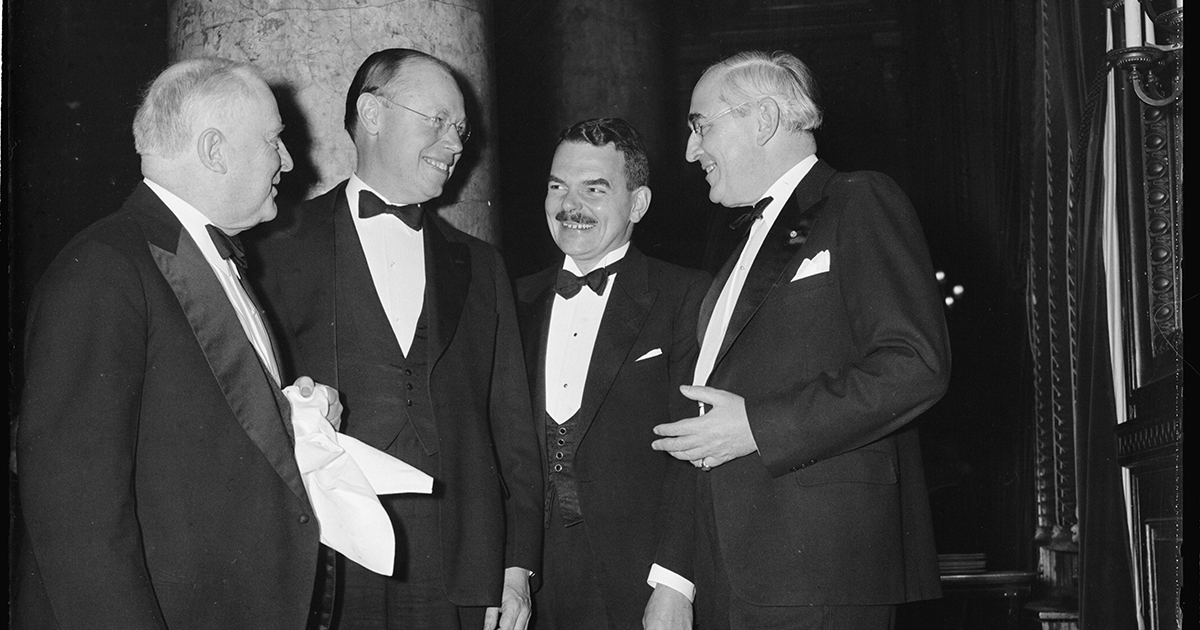Film recasts crusading journalist in modern context

LAWRENCE – Speaking out against racism and political demagoguery, for free speech and factual news coverage, putting principle ahead of party – the issues Kansas journalist William Allen White championed a century ago could be torn from today’s headlines. Kevin Willmott's new documentary shows White as a truly modern figure whose beliefs about democracy resonate deeply with current affairs.
 “William Allen White: What’s the Matter with Kansas?” is the latest directorial effort from Willmott, creator of such films as "Jayhawkers" (2014) and "C.S.A.: Confederate States of America" (2004) and screenwriter of "Chi-Raq" (2015) and the forthcoming "Black Klansman" with Spike Lee. The film, whose production was funded by the William Allen White Foundation and the KU Endowment Association, has its premiere at 5:30 p.m. April 25 in 3139 Wescoe Hall. It is free and open to the public.
“William Allen White: What’s the Matter with Kansas?” is the latest directorial effort from Willmott, creator of such films as "Jayhawkers" (2014) and "C.S.A.: Confederate States of America" (2004) and screenwriter of "Chi-Raq" (2015) and the forthcoming "Black Klansman" with Spike Lee. The film, whose production was funded by the William Allen White Foundation and the KU Endowment Association, has its premiere at 5:30 p.m. April 25 in 3139 Wescoe Hall. It is free and open to the public.
“He is the example of what makes and what made Kansas great,” said Willmott, professor of film & media studies. “He ran the Ku Klux Klan out of Kansas in the 1920s.”
In that period, after the success of the 1915 film “The Birth of a Nation (The Clansman),” the Klan spread like wildfire across the Midwest.
“It took over Indiana, and they just about took over Kansas,” Willmott said. “They were in every city in the state. There were 6,000 official members in Wichita alone. They had huge parades and gatherings. They would march in the Fourth of the July parade. There was the Kiwanis, the Elks, the Eagles and the Klan. They were just a totally normal thing.”
Things got so bad that by 1924, long after White became famous as “the Sage of Emporia” and the year after he won the Pulitzer Prize, he ran for governor as an independent in a bid to expose the Klan.
“Because the Democrats and the Republicans were both in the Klan’s pockets, he had to run to expose the problem,” Willmott said. “So he ran as an independent, which was a tough thing for him, because he was a die-hard Republican Party man. For him to have to step out of his beloved party shows how bad the situation was.”
While White didn’t become governor, he supported other candidates who opposed the Klan, and eventually laws were passed that denied the KKK a state organizational charter, which “effectively made them illegal,” Willmott said. “If White had not done that, we could easily have turned into another Indiana or Oklahoma, or worse, another Mississippi or Alabama.”
White came to national prominence in 1896 as a right-wing critic of the left-leaning populist movement that had taken root in Kansas and across the nation. His column titled “What’s the Matter with Kansas?” was a scathing attack on Democratic presidential candidate William Jennings Bryan and the likes of Kansas populist congressman “Sockless Jerry” Simpson, who railed against the railroad barons and other powers that be during the economic depression in rural America that presaged the Great Depression.
“They have a big fight where the governor had to send troops to the Statehouse to keep the parties from going at each other,” Willmott said of the episode that is today called “The Legislative War” of 1892. “Literally, there are photographs of a Gatling gun in the Kansas Statehouse. These guys were really at each other’s throats.”
This sort of political disorder was hurting Kansas economically, White wrote.
“In today’s terms, it went viral,” Willmott said.
White’s editorial was reprinted in newspapers across the country, and the Republican Party turned it into pamphlets supporting their presidential candidate that year, William McKinley.
“That’s what made White famous was this editorial, which is a right-wing attack on a bunch of crazy lefties,” Willmott said. “What’s really cool is that a few years later, he starts to see that they weren’t all wrong; these populist guys had some points to make. It’s mainly through his relationship with Teddy Roosevelt that White starts to change his ideas. He had a saying: ‘Teddy bit me.’
“So White starts to see ‘I was wrong about that editorial.’ He ends up saying, ‘I wrote it in haste, in a highly emotional state,’ and he kind of apologized for it the rest of his life, which is really great, because today you rarely see someone in public life who comes back and says, ‘I wasn’t quite right about that’ – especially about the thing that made them famous.”
Willmott said White tacked to the political left for the rest of his life, opposing the Red Scare of the 1920s, the Palmer Raids and the Klan – all motivated by anti-immigrant sentiment.
“He starts to form these notions about how important free speech and the First Amendment is,” Willmott said, “and these things become for him small-town values. He does all this from Emporia. And whereas other people speaking about these things are doing it mainly from New York, he’s got this national voice, but it’s always based in small-town America.”
White fought charlatans in every form — from yellow journalism to the infamous quack goat-gland-implanting “doctor” John Brinkley.
“White really is a modern figure,” Willmott said. “So many of the things he said about demagogues and people who can easily dupe others and wield power in a democratic society really speak to a lot of issues today.”
After the on-campus premiere, Willmott said he hopes the film will be shown on PBS television stations locally and nationally. A shortened version will be produced for use in classrooms.
Top photo: In this 1940 photo, from the Harris & Ewing Collection of the Library of Congress, then-president of the American Society of Newspaper Editors William Allen White (from left) met with Sen. Robert A. Taft of Ohio, Thomas E. Dewey and Sen. Arthur H. Vandenberg of Michigan at a society dinner.
Right photo: Professor Kevin Willmott. Credit: KU Marketing Communications.